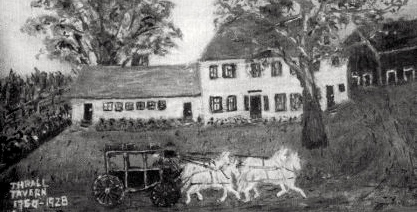|
Can you answer these Trivia Questions about Bloomfield?
1. When did St. Thomas Seminary move to Bloomfield?
2. What student of Rev. Bissell, Wintonbury’s first minister,
became the first black minister of a Torrington Church?
3. How far is it from Bloomfield to Massachusetts as the crow flies?
4. Who was the first person buried in the Old Wintonbury Cemetery?
5. What Bloomfield musical group performed at the Knoxville World’s Fair?
WINTONBURY TAVERNS
In Wintonbury/Bloomfield, the stagecoach was the only public conveyance until the railroads came in the 1870s. Many taverns were built along the stage routes in the 18th and 19th centuries for the convenience of the travelers. However, the tavern was of far greater importance to its local neighbors for sociability, imbibing liquors and for the interchange of news and opinions.
The Buttonball Tavern, also called Thrall Tavern, was at the northeast corner of Wintonbury and Blue Hills Avenues where the Bethel AME Church is today.  It was built by the Thrall family about 1760 on the old Granby Turnpike. It was here on a visit to Hartford in the early 1800s that General Lafayette was entertained with one hundred or more guests. Although the tavern burned about 1933, the buttonball (sycamore) tree remained there for many years. It was built by the Thrall family about 1760 on the old Granby Turnpike. It was here on a visit to Hartford in the early 1800s that General Lafayette was entertained with one hundred or more guests. Although the tavern burned about 1933, the buttonball (sycamore) tree remained there for many years.
On the northeast corner of Hoskins and Adams Roads stood the (William) Adams Tavern built in 1750. It was one of the most popular taverns of its day and also served as a stagecoach stop on the route to Westfield. At that time Terry Plains Road continued on to Hoskins and then over the mountain to Simsbury. The tavern was also a place where letters were dropped off for people in the area before U.S. Postal delivery started.
The building that was the Joseph Goodwin Tavern, built in 1746, is now a residence on Duncaster Road. Just when and for how long it was a tavern is not clear. The central chimney was huge and one of its fireplaces could accommodate an eight foot log.
The house at the corner of West Street and Simsbury Road, next to Wades Vegetable Stand, was built by Grove Barnard before 1850 as a country store and licensed for a tavern. We have no details about its use as a tavern but in 1855, the Ely brothers bought the land and used it for years as a landscape nursery.
On Simsbury Road, the house known as the Prosser Inn was built in 1760 by a Cadwell. From as early as 1700, this location was the headquarters of the Hartford-to-Westfield stage line. James Prosser purchased the house in 1830 and after remodeling named it “Prosser Inn.” Mr. Prosser’s son, Levi, bequeathed $16,255.85 to the Prosser Library and a like sum to the Congregational Church for needy persons over sixty years age.
The earliest building on the site of the present Prosser Library was built in 1790. Although its original use is not known, in 1858 it became the Brown and Griffin Tavern , noted for its genial hospitality, good food and parties. It also served as the headquarters for the stagecoach line from Hartford to Tariffville. Edward S. Brown and Alfred S. Griffin, who also owned the stage line, took turns driving, changing horses at the tavern. The stage also carried the mail and the Hartford Courant. The tavern was destroyed by fire in 1878 and replaced in 1903 with a building that was used as the town hall and the original Prosser Library.
Tariffville Road and Blue Hills Avenue were known as the Granby Turnpike. At the corner of Tariffville and Duncaster Roads is the old Hoskins Tavern built in 1832 by Rockwell Hoskins. Operated as a tavern from 1832 to 1850, it had a long dining hall and a tap room and a dance hall on the second floor. Although the tavern occasionally put up travelers overnight, more importantly it was a place where they could stop for a meal. In addition to three times a week stagecoach service in each direction, it was frequented by farmers driving their ox-teams to and from Hartford. During the time that the house was actively used as a tavern, the floor in the tap room became so worn that it had to be replaced with boards from the attic floor. Following the laying of tracks of the Central New England Railway right through the property in the 1870s, Rockwell Hoskins’ son Henry closed the tavern and concentrated on farming.
by Ralph Schmoll
Wintonbury Historical Society |